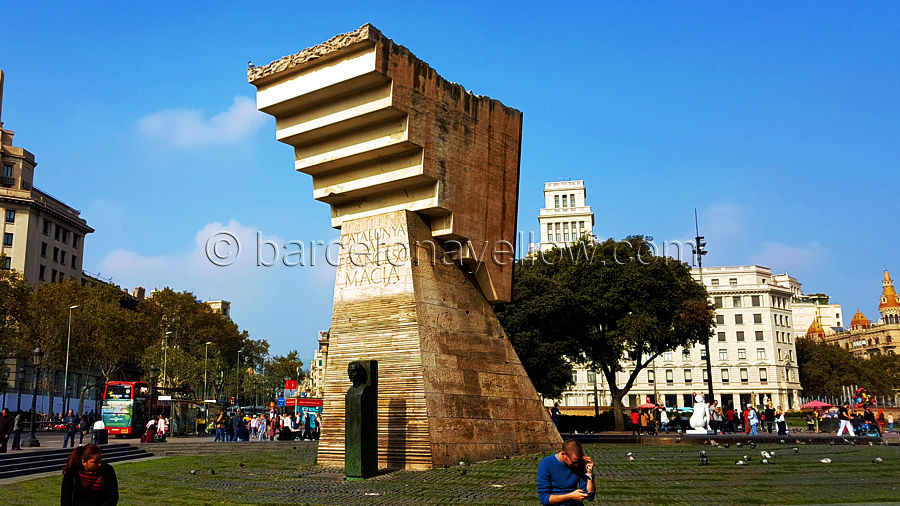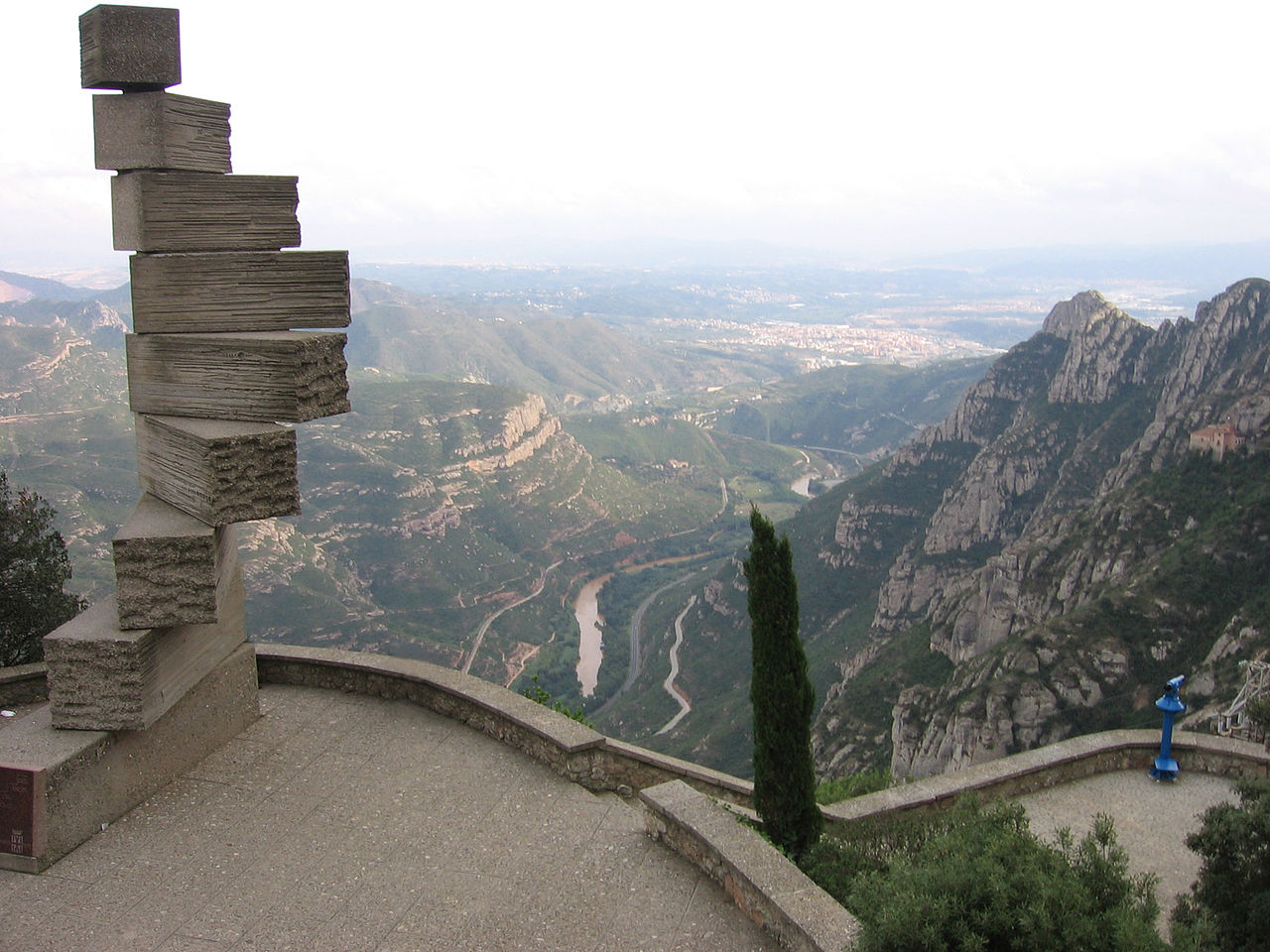| HOME |
| Hotels |
| Apartments |
| Attractions |
| Restaurants |
| Tickets & tours shop |
| Tours |
| Maps & travel planners |
| Airports & transport |
| Maps |
| Events |
| Shopping |
| Contact us |
|
| Biography Josep Maria Subirachs - architect and artist |
Biography Josep Maria SubirachsJosep Maria Subirachs was born on March 11, 1927 in Barcelona. His full name was Josep Maria Subirachs i Sitjar. Subirachs was a Catalan/Spanish sculptor and artist of the late 20th century. His best known work is the Passion Facade of the basilica of the Sagrada Família, but you can find many magnificent Subirachs works all over Barcelona and Catalonia including in Girona and at Montserrat abbey.  Subirachs was born into a working class family in the Barcelona district of Poblenou. Poverty after the Spanish Civil War forced him to give up his dream of studying architecture and he began working at the workshop of a gilder and amateur sculptor at age fourteen years. Even at this young age, he was modeling clay figures which he used to bring to the furnace of a local roof tile factory. From 1942 to 1947 he worked as an apprentice under the sculptor Enric Monjo at his workshop. The person who influenced Subirachs most was Enric Casanovas, with whom he worked for a brief period prior to Casanovas' death in 1948 just a fews months after Subirachs started at his workshop. The strong influence of Casanovas is apparent in the young sculptor's early works, although the stylization of the figures exhibited at his first individual exhibit held in Barcelona in 1948 were already showing signs of what would later become Subirachs' expressionist phase. The expressionist aspect of Subirachs' works is expressed in the typically distorted angular bodies and in the treatment of textures, when he uses a technique called grattage to make surfaces rough, jagged and coarse, in order to accentuate the expressive capacity of the material. In 1950 Subirachs founded, alongside the sculptors Francesc Torres Monsó and Martí Sabé and the painters Esther Boix, Ricard Creus and Joaquim Datzira, the "Postectura" group, which presented itself with an exhibition and a manifest at the Galeries Laietanes in Barcelona. The following year the Circle Maillol of the French Institute of Barcelona awarded him a scholarship to extend his studies in Paris, where he came into contact with the latest European avant-gardes and took great pleasure in discovering the work of the British sculptor Henry Moore. His participation in the II Saló d'Octubre, held in Barcelona in 1949, brought him public acclaim and until 1957 he participated steadily in this showroom. It was at the Saló d'Octubre that the Belgian painter Luc Peire discovered the work of Subirachs and took an interest in it, inviting him to move to Belgium. Accepting the offer, the Catalan sculptor moved to Belgium, where he lived and worked between 1954 and 1956, holding both individual and collective exhibitions in Brussels, Bruges, Knokke and at the Antwerp Biennial Exhibition in 1955. It was then, when Subirachs realised that he could make a living out of his work and he became a professional sculptor. Below: Monumento a Francesc Macià (1991) on Plaza de Cataluña  From expressionism he moved into abstraction, in a process towards a new personal style which, towards the end of the 1950s, led him to take an interest in iron. Around this time he worked with other materials such as stone, bronze, copper, cement, fibrocement, clay or wood, striving to bring out of each material the plastic qualities of their varied structures, colours and textures. Between 1957 and 1960 Subirachs began his significant contribution to the field of public sculpture. In the year 1957 Form 212 - his first abstract work in a public thoroughfare - was unveiled in Barcelona. The following year his relief The Tables of the Law, created in conjunction with the ceramic artist Antoni Cumella, was incorporated into the façade of the University of Barcelona's Law School building; and in 1960 he caused great controversy with the work "Evocation of the Sea" located in the Barceloneta. During this period he worked on the Virgen del Camino sanctuary, which was inaugurated in León in 1961, and for which he created the thirteen bronze monumental figures in the façade, four bronze doors and several other elements housed within the temple. This group of monuments, the culmination of the artist's expressionist stage, has been considered a milestone in the artistic renovation of Spain in the 20th century. In the midst of his experimentation with abstract language, Subirachs begins the stage that J. Corredor-Matheos classifies as the 'penetrations and tensions' stage, with stamps and shims fit together and straps and iron bolts as the most commonly used plastic elements. Towards 1965, he sets his sights on endowing his work with more communicative elements and, in order to achieve this, he opts for a new figuration. However, this is not a representative figuration, but rather a new meaningful figuration characterized by the introduction of plastic resources such as continuous profiles, moulds and turned shapes, as well as classical elements such as niches, capitals, caryatids and balustrades. And in the early seventies, he also incorporates realistic pictorial elements. This is also the stage in which he consolidates the analysis of dualities and oppositions: horizontal and vertical, positive and negative, male and female, space and time, life and death, whilst also incorporating a series of symbolic elements such as the Tower of Babel, the labyrinth, the phallic obelisk, the pubis tree, the stairway of intellection, Moebius' strip and other elements which comprise the iconographic universe that singularly defines his work. In 1986 Subirachs was commissioned to undertake a project of extraordinary proportions: the groups of sculptures on the Passion Façade of the Sagrada Família in Barcelona designed by Antoni Gaudí; the emblematic work by the brilliant architect Antoni Gaudí. Subirachs dedicated almost twenty years (1987 to 2005) to this group of works, which can be considered the synthesis and culmination of his career as a sculptor, comprising more than one hundred figures sculpted in stone and four bronze doors. Subirachs was commissioned in 1986 to complete the Passion Façade of the Sagrada Família. The façade depicts scenes from the Passion of Christ, including his crucifixion and resurrection. Subirachs' style was known for its stark, angular lines and modernist aesthetic, which was a departure from the organic forms favored by Gaudí. The sculptures on the Passion Façade are highly symbolic, with each figure representing a different aspect of Christ's suffering and sacrifice. The central figure, a Christ figure, is depicted with elongated arms and legs, emphasizing his physical agony. Other figures include a group of women mourning the death of Christ, and an angel holding a chalice representing the Holy Grail. The Passion Façade was controversial at the time of its completion, as some critics felt that it was a departure from the organic, flowing style of Gaudí. However, over time it has come to be recognized as a powerful and unique work of art in its own right, and it has become one of the most popular attractions at the Sagrada Família. Below: Monumento a Ramon Llull (1976) at Montserrat monastery near Barcelona  A multi-faceted artist, Subirachs has not only expressed himself through tridimensional creation, but also by means of other techniques such as painting, drawing, graphic art (etching, drypoint, serigraphy and lithography), tapestry, book illustration, medal minting and designing jewellery and other utilities. In addition to a significant international projection, with numerous exhibitions held and works on show in cities and collections all over the world, mention should be given to the presence of his work all over Catalonia, with several monumental works. During the last years of his life, Josep Maria Subirachs could not continue to be active in the world of art due to his neurodegenerative disease. He passed away in Barcelona on 7th April 2014 at the age of 87. © Copyright Barcelonayellow.com Do not copy from this page without permission All rights reserved. |
| Last Updated on Sunday, 12 January 2025 17:09 |
|
|
Sunday, 14 September 2025

Barcelona Spain - Barcelona Travel Guide - Copyright 2007-2025
Privacy Policy and Cookies • Legal Disclaimer • Copyright
BarcelonaYellow SiteMap 2025
Barcelona Latest News:
COVID-19 - Barcelona Latest News
Barcelona Safety Guide 2025
Barcelona Top 10 attractions 20254
Plan 3 days in Barcelona 2025
About us
About us
Contact us
Privacy Policy and Cookies
Copyright notice
Legal disclaimer
Twitter Barcelona events
Partnerships
Advertising
COVID-19 - Barcelona Latest News
Barcelona Safety Guide 2025
Barcelona Top 10 attractions 20254
Plan 3 days in Barcelona 2025
About us
About us
Contact us
Privacy Policy and Cookies
Copyright notice
Legal disclaimer
Twitter Barcelona events
Partnerships
Advertising
Accommodation
Hotels in Barcelona
Hotels near Fira Exhibition
Hotels near Camp Nou
Hotels near Cruise Ships
Short Stay Apartments
Practical information
Useful visitor information
How to get to Barcelona airport
Cruise Ship Terminals
Barcelona maps
Airport buses
Barcelona metro
Taxis
Travel cards
Hotels in Barcelona
Hotels near Fira Exhibition
Hotels near Camp Nou
Hotels near Cruise Ships
Short Stay Apartments
Practical information
Useful visitor information
How to get to Barcelona airport
Cruise Ship Terminals
Barcelona maps
Airport buses
Barcelona metro
Taxis
Travel cards
Things to do
Top 10 attractions Barcelona
Photos of Barcelona
Restaurant Guide
Nightlife Guide
Things to do in Barcelona
Barcelona beaches
Book tours and tickets
Skiing near Barcelona
Weather Barcelona
Weather in Barcelona
5 day forecast Barcelona
Top 10 attractions Barcelona
Photos of Barcelona
Restaurant Guide
Nightlife Guide
Things to do in Barcelona
Barcelona beaches
Book tours and tickets
Skiing near Barcelona
Weather Barcelona
Weather in Barcelona
5 day forecast Barcelona
Top Festivals and events
Barcelona Events 2025
Christmas in Barcelona
New Years Eve 2025
MWC 2025 Barcelona
Sant Jordi's Day
Barcelona Marathon
Barcelona Half Marathon
Easter
Festa de Gracia
La Merce Festival
FC Barcelona calendar
Barcelona Events 2025
Christmas in Barcelona
New Years Eve 2025
MWC 2025 Barcelona
Sant Jordi's Day
Barcelona Marathon
Barcelona Half Marathon
Easter
Festa de Gracia
La Merce Festival
FC Barcelona calendar
Moving to Barcelona
Moving to Barcelona
Long term apartment rentals
Relocation agencies
Real estate agencies
Spanish schools
Meeting people
Finding work
Yellow pages directory
Partner websites:
DayTripsBarcelona.com
Stepbac.com
PhotoMemoirs.co
Helpfurl.com
Moving to Barcelona
Long term apartment rentals
Relocation agencies
Real estate agencies
Spanish schools
Meeting people
Finding work
Yellow pages directory
Partner websites:
DayTripsBarcelona.com
Stepbac.com
PhotoMemoirs.co
Helpfurl.com
